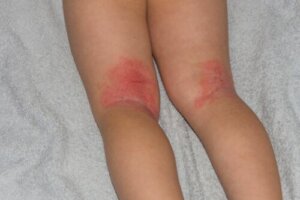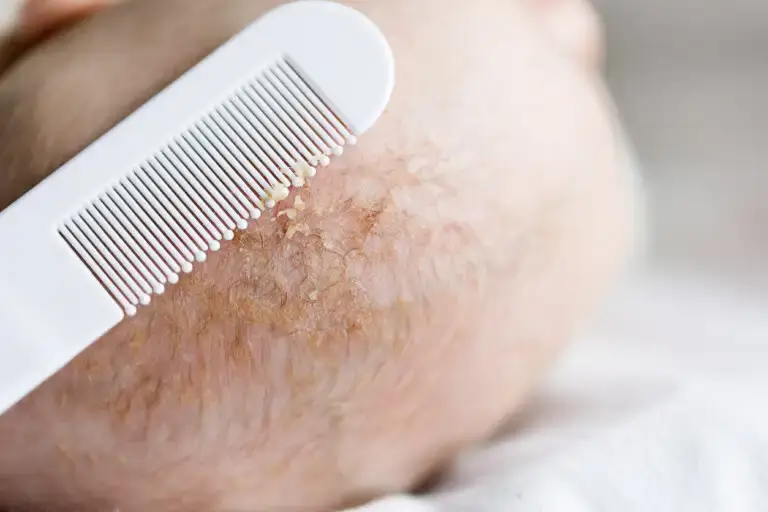Erythroderma in Children: Symptoms, Causes, and Treatments


Written and verified by the dermatologist Maria del Carmen Hernandez
Erythroderma in children isn’t one of the most commonly diagnosed skin manifestations in pediatric care. It’s a rare skin disease with few proven and supported studies in infants.
What is erythroderma?
Erythroderma is also known as generalized exfoliative dermatitis. Therefore, it’s a disease of the skin with inflammatory characteristics in which about 90% of the body surface presents desquamation and redness.
Like most diseases, it can present itself in an acute or chronic form, depending on the time of its evolution.
The causes of erythroderma in children
This disease can be triggered by various acquired or hereditary diseases or by the intake of drugs. Also, the causes may be different depending on the age of the patient. However, the histological features and clinical manifestations of erythroderma are often similar.
The use of certain medications
Very little information is available, but drug-induced erythroderma is common in children with a history of upper respiratory tract infections or epilepsy. Therefore, some of the drugs associated with generalized exfoliative dermatitis include the following:
- Sulfonamides
- Antiepileptics
- Antimalarials
- Antibiotics (streptomycin, amoxicillin, penicillin)
- Isoniazid
- Nonsteroidal anti-inflammatory drugs
- Homeopathics
- Cimetidine
- Captopril
As soon as a drug is proven to be the cause, it should be removed and the corresponding symptomatic treatment should be administered.
Infections
Infections in children usually appear with mild skin lesions. In very rare cases, however, generalized exfoliative dermatitis may be triggered. Infections, therefore, account for 40 % of the causes of erythroderma.
- Staphylococcal scalded skin syndrome: This is a skin pathology caused by staphylococcal exfoliative toxins. This toxin has the property of breaking intercellular junctions and generating blisters, with greater prevalence in children under 5 years of age and neonates.
- Congenital cutaneous candidiasis: This develops due to an infection produced in an ascending way from the vagina. At birth, the baby presents a rash with macules and papules.
Read also: Infantile ringworm: symptoms, causes and treatment
Ichthyosiform erythroderma
Ichthyoses are a wide range of disorders of the keratinization process that have constant desquamation as a common property. In addition to the cutaneous clinical manifestations of the disease, it sometimes appears with systemic involvement.
Atopic dermatitis
Although atopic disease is one of the most common skin disorders during childhood, its erythrodermic manifestation is uncommon.
Similarly, the corresponding anamnesis should be performed and a personal or family history of atopic dermatitis should be ruled out. If there’s a personal or family history of atopy, the following may also be observed:
- Lichenification
- Increased linear weave on the palms
- Dennie Morgan’s crease

Infantile seborrheic dermatitis
Infantile seborrheic dermatitis begins in the first month of the child’s life. It’s characterized by the presence of yellow scales on the scalp and in the neck, armpits, retroauricular, and groin crease regions.
There are three variants of infantile seborrheic dermatitis: True, psoriasiform, and erythrodermic. However, the erythrodermic form is rarely seen.

Clinical manifestations of erythroderma
Erythroderma has the same symptoms and signs at any age at which it presents. However, the difference lies in the severity with which it develops in each patient. The most frequent symptoms at the time of consultation are a burning sensation (41%) and itching (18%) according to studies conducted by The Journal of Dermatology.
The predominant lesions on the skin surface are scaling, blisters, and erythema. In turn, there are cases in which the following conditions are evidenced:
- Lymphadenopathy
- Elevated temperature
- Tachycardia
- Hepatomegaly
- Edema in feet
- Nail involvement
Also, according to the causative factor of erythroderma, the child’s symptoms will be more varied and extensive.
You may be interested in: Dry Skin in Infants
Therapeutic options for the management of erythroderma in children
The main thing to be able to face an adequate treatment is to make an accurate diagnosis and establish the cause that triggered it. Medical care is based on reducing inflammation, itching, and discomfort in the child. In turn, an infection could be a serious complication of this disease, so its management should be addressed quickly.
In more severe cases, therapeutic measures will be aimed at correcting dehydration, low blood volume, heat loss, and electrolyte and nutrient deficiencies. The application of moist dressings, antifungals, emollients, and topical corticosteroids to the affected areas is good medical practice.
Final considerations of erythroderma in children
One of the most important aspects is to recognize the symptoms and make the diagnosis early because, in some cases, it can be life-threatening for the child. It goes without saying that the therapeutic management and prognosis of the disease depend on the cause that triggered it.
Erythroderma in children isn’t one of the most commonly diagnosed skin manifestations in pediatric care. It’s a rare skin disease with few proven and supported studies in infants.
What is erythroderma?
Erythroderma is also known as generalized exfoliative dermatitis. Therefore, it’s a disease of the skin with inflammatory characteristics in which about 90% of the body surface presents desquamation and redness.
Like most diseases, it can present itself in an acute or chronic form, depending on the time of its evolution.
The causes of erythroderma in children
This disease can be triggered by various acquired or hereditary diseases or by the intake of drugs. Also, the causes may be different depending on the age of the patient. However, the histological features and clinical manifestations of erythroderma are often similar.
The use of certain medications
Very little information is available, but drug-induced erythroderma is common in children with a history of upper respiratory tract infections or epilepsy. Therefore, some of the drugs associated with generalized exfoliative dermatitis include the following:
- Sulfonamides
- Antiepileptics
- Antimalarials
- Antibiotics (streptomycin, amoxicillin, penicillin)
- Isoniazid
- Nonsteroidal anti-inflammatory drugs
- Homeopathics
- Cimetidine
- Captopril
As soon as a drug is proven to be the cause, it should be removed and the corresponding symptomatic treatment should be administered.
Infections
Infections in children usually appear with mild skin lesions. In very rare cases, however, generalized exfoliative dermatitis may be triggered. Infections, therefore, account for 40 % of the causes of erythroderma.
- Staphylococcal scalded skin syndrome: This is a skin pathology caused by staphylococcal exfoliative toxins. This toxin has the property of breaking intercellular junctions and generating blisters, with greater prevalence in children under 5 years of age and neonates.
- Congenital cutaneous candidiasis: This develops due to an infection produced in an ascending way from the vagina. At birth, the baby presents a rash with macules and papules.
Read also: Infantile ringworm: symptoms, causes and treatment
Ichthyosiform erythroderma
Ichthyoses are a wide range of disorders of the keratinization process that have constant desquamation as a common property. In addition to the cutaneous clinical manifestations of the disease, it sometimes appears with systemic involvement.
Atopic dermatitis
Although atopic disease is one of the most common skin disorders during childhood, its erythrodermic manifestation is uncommon.
Similarly, the corresponding anamnesis should be performed and a personal or family history of atopic dermatitis should be ruled out. If there’s a personal or family history of atopy, the following may also be observed:
- Lichenification
- Increased linear weave on the palms
- Dennie Morgan’s crease

Infantile seborrheic dermatitis
Infantile seborrheic dermatitis begins in the first month of the child’s life. It’s characterized by the presence of yellow scales on the scalp and in the neck, armpits, retroauricular, and groin crease regions.
There are three variants of infantile seborrheic dermatitis: True, psoriasiform, and erythrodermic. However, the erythrodermic form is rarely seen.

Clinical manifestations of erythroderma
Erythroderma has the same symptoms and signs at any age at which it presents. However, the difference lies in the severity with which it develops in each patient. The most frequent symptoms at the time of consultation are a burning sensation (41%) and itching (18%) according to studies conducted by The Journal of Dermatology.
The predominant lesions on the skin surface are scaling, blisters, and erythema. In turn, there are cases in which the following conditions are evidenced:
- Lymphadenopathy
- Elevated temperature
- Tachycardia
- Hepatomegaly
- Edema in feet
- Nail involvement
Also, according to the causative factor of erythroderma, the child’s symptoms will be more varied and extensive.
You may be interested in: Dry Skin in Infants
Therapeutic options for the management of erythroderma in children
The main thing to be able to face an adequate treatment is to make an accurate diagnosis and establish the cause that triggered it. Medical care is based on reducing inflammation, itching, and discomfort in the child. In turn, an infection could be a serious complication of this disease, so its management should be addressed quickly.
In more severe cases, therapeutic measures will be aimed at correcting dehydration, low blood volume, heat loss, and electrolyte and nutrient deficiencies. The application of moist dressings, antifungals, emollients, and topical corticosteroids to the affected areas is good medical practice.
Final considerations of erythroderma in children
One of the most important aspects is to recognize the symptoms and make the diagnosis early because, in some cases, it can be life-threatening for the child. It goes without saying that the therapeutic management and prognosis of the disease depend on the cause that triggered it.
All cited sources were thoroughly reviewed by our team to ensure their quality, reliability, currency, and validity. The bibliography of this article was considered reliable and of academic or scientific accuracy.
- Sarkar R, Garg VK. Erythroderma in children. Indian J Dermatol Venereol Leprol. 2010 Jul-Aug;76(4):341-7. doi: 10.4103/0378-6323.66576. PMID: 20657113.
- Sarkar R, Sharma RC, Koranne RV, Sardana K. Erythroderma in children: a clinico-etiological study. J Dermatol. 1999 Aug;26(8):507-11. doi: 10.1111/j.1346-8138.1999.tb02036.x. PMID: 10487005.
- Sehgal VN, Srivastava G. Exfoliative dermatitis. A prospective study of 80 patients. Dermatologica. 1986;173(6):278-84. PMID: 2950005.
- Sehgal VN, Srivastava G, Sardana K. Erythroderma/exfoliative dermatitis: a synopsis. Int J Dermatol. 2004 Jan;43(1):39-47. doi: 10.1111/j.1365-4632.2004.01975.x. PMID: 14693020.
- Menni S, Piccinno R, Baietta S, Ciuffreda A, Scotti L. Infantile seborrheic dermatitis: seven-year follow-up and some prognostic criteria. Pediatr Dermatol. 1989 Mar;6(1):13-5. doi: 10.1111/j.1525-1470.1989.tb00259.x. PMID: 2523038.
This text is provided for informational purposes only and does not replace consultation with a professional. If in doubt, consult your specialist.








